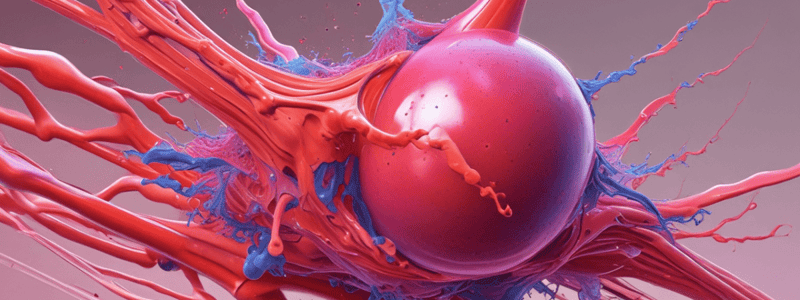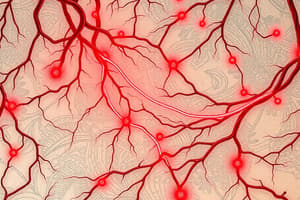Podcast
Questions and Answers
What is the primary force that tends to force fluid outward through the capillary membrane?
What is the primary force that tends to force fluid outward through the capillary membrane?
- Capillary plasma colloid osmotic pressure
- Interstitial fluid colloid osmotic pressure
- Interstitial fluid hydrostatic pressure
- Capillary hydrostatic pressure (correct)
When does the interstitial fluid hydrostatic pressure tend to force fluid outward through the capillary membrane?
When does the interstitial fluid hydrostatic pressure tend to force fluid outward through the capillary membrane?
- When it is 5 mm Hg or lower
- When it is 20 mm Hg or higher
- When it is positive
- When it is negative (correct)
What is the role of capillary plasma colloid osmotic pressure in fluid movement through capillary membranes?
What is the role of capillary plasma colloid osmotic pressure in fluid movement through capillary membranes?
- Tends to cause osmosis of fluid outward
- Has no influence on fluid movement
- Tends to force fluid inward (correct)
- Neutralizes the other forces
What happens if the net filtration pressure is positive?
What happens if the net filtration pressure is positive?
What is the main consequence of decreased baroreceptor input to the brain?
What is the main consequence of decreased baroreceptor input to the brain?
Which of the following Starling forces leads to osmosis of fluid inward through the capillary membrane?
Which of the following Starling forces leads to osmosis of fluid inward through the capillary membrane?
Which region of the circulation is particularly affected by sympathetic vasoconstriction during hemorrhage?
Which region of the circulation is particularly affected by sympathetic vasoconstriction during hemorrhage?
When will there be a net fluid absorption from the interstitial spaces into the capillaries based on Starling forces?
When will there be a net fluid absorption from the interstitial spaces into the capillaries based on Starling forces?
Which force primarily drives fluid filtration across the capillary vessel wall?
Which force primarily drives fluid filtration across the capillary vessel wall?
What is the purpose of the sympathetically mediated venoconstriction during hemorrhage?
What is the purpose of the sympathetically mediated venoconstriction during hemorrhage?
What is the role of starling forces in fluid movement across the capillary wall?
What is the role of starling forces in fluid movement across the capillary wall?
At what level of blood loss does the sympathetic activation become succeeded by inhibition of sympathetic outflow and progression to circulatory shock?
At what level of blood loss does the sympathetic activation become succeeded by inhibition of sympathetic outflow and progression to circulatory shock?
How does the brain and coronary circulations respond to sympathetic vasoconstriction during hemorrhage?
How does the brain and coronary circulations respond to sympathetic vasoconstriction during hemorrhage?
In which region of the capillary do forces favoring filtration dominate?
In which region of the capillary do forces favoring filtration dominate?
What is the main effect of decreased baroreceptor input on the parasympathetic nerve supply to the heart?
What is the main effect of decreased baroreceptor input on the parasympathetic nerve supply to the heart?
How does blood loss affect arterial blood pressure?
How does blood loss affect arterial blood pressure?
What is the purpose of compensatory responses triggered by CVS reflexes after blood loss?
What is the purpose of compensatory responses triggered by CVS reflexes after blood loss?
Which organ plays a crucial role in the long-term restoration of blood volume following hemorrhage?
Which organ plays a crucial role in the long-term restoration of blood volume following hemorrhage?
What is the function of the precapillary sphincter?
What is the function of the precapillary sphincter?
What causes the intermittent periods of capillary blood flow known as vasomotion?
What causes the intermittent periods of capillary blood flow known as vasomotion?
What plays a crucial role in determining the degree of opening and closing of metarterioles and precapillary sphincters?
What plays a crucial role in determining the degree of opening and closing of metarterioles and precapillary sphincters?
What does capillary tone refer to?
What does capillary tone refer to?
How does the local tissue affect the function of metarterioles and precapillary sphincters?
How does the local tissue affect the function of metarterioles and precapillary sphincters?
What happens to capillary blood flow when tissue oxygen usage is high and oxygen concentration decreases?
What happens to capillary blood flow when tissue oxygen usage is high and oxygen concentration decreases?
What is the expected mean arterial blood pressure range after a 15 – 20% hemorrhage?
What is the expected mean arterial blood pressure range after a 15 – 20% hemorrhage?
How does decreased blood volume affect right atrial pressure and cardiac output?
How does decreased blood volume affect right atrial pressure and cardiac output?
What happens to mean arterial pressure when there is a 20% reduction in blood volume?
What happens to mean arterial pressure when there is a 20% reduction in blood volume?
What is the consequence of a blood volume loss of 30 – 40% on mean arterial blood pressure?
What is the consequence of a blood volume loss of 30 – 40% on mean arterial blood pressure?
Which regulatory mechanism plays a role in restoring blood pressure after hemorrhage?
Which regulatory mechanism plays a role in restoring blood pressure after hemorrhage?
What is the expected cardiac output after a 20% reduction in blood volume?
What is the expected cardiac output after a 20% reduction in blood volume?
Flashcards are hidden until you start studying



